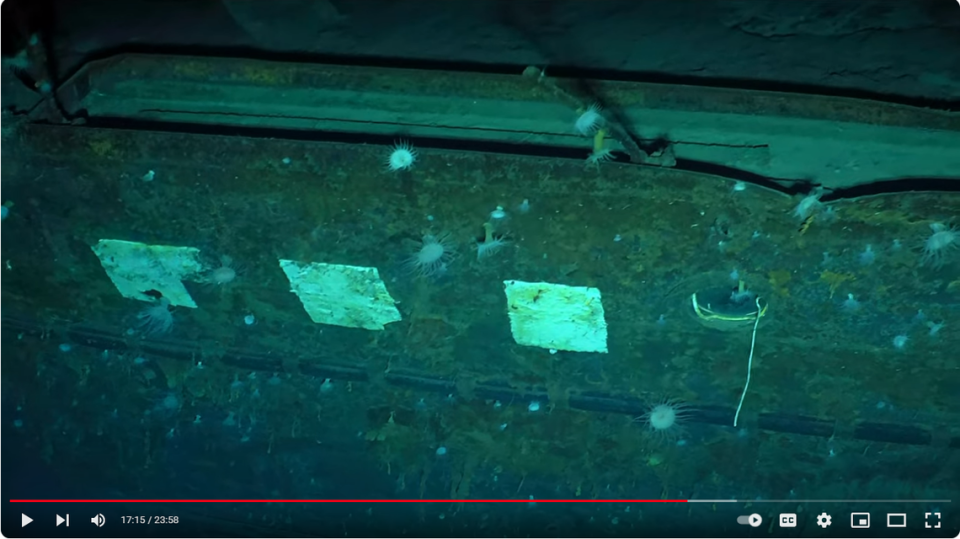Identity of massive WWII shipwreck confirmed when team finds name still etched on bow
An international team working to confirm the identify of a World War II shipwreck made a “haunting” discovery when it found the ship’s name embossed on the bow, despite being on the Pacific Ocean floor for 81 years.
The team, led by Ocean Exploration Trust, reports the massive wreck is that of the Imperial Japanese Navy aircraft carrier Akagi, which was scuttled during the Battle of Midway in 1942.
“It’s rare when a ship actually tells you its name,” the crew reported from the seafloor. “This is a pretty important moment in this exploration.”

A giant chrysanthemum emblem — likely once painted gold — was found on the bow, noting the 855-foot vessel was property of the Japanese emperor, officials said.
Deciphering the name of the vessel was made all the more challenging because the symbols had been covered in white paint before going into battle, perhaps to keep U.S. forces from identifying it, the team reports.
However, a remotely operated camera found the outline of the original Japanese characters were stenciled into the metal beneath the eroding paint, officials said.
“This feels especially sacred and important,” one team member said in video of the discovery. “Such an honor to bear witness to this.”
Large guns were also found around the ship, their barrels still pointed at targets that no longer exist. The guns are additional proof of the wreck’s identity, because the Akagi was a fully armed battle cruiser that was later converted into an aircraft carrier, historians say.
The expedition began Sept. 8 on the Exploration Vessel Nautilus and counts as first attempt at a visual survey of the wreck. It sits 3 miles deep in Papahānaumokuākea Marine National Monument, about 980 miles northwest of Hawaii. The crew will continue mapping the seafloor in the region through Sept. 28.
A remote camera spent 14 hours circling the wreck, revealing catastrophic damage resulted when a U.S. pilot dropped a 1,000-pound bomb near an airplane elevator. The bomb penetrated the deck and detonated in the hangar among “the fully armed and fueled torpedo bombers being prepared for an airstrike against the American fleet.”
Many of the 267 crew members who died were trapped below the fires in the engineering space, historians say.
“Before sunrise on June 5, (1942), as raging fires continued to burn aboard Akagi, (Japanese) destroyers Arashi, Hagikaze, Maikaze, and Nowaki each fired one torpedo into the former flagship, sinking it bow first,” Nautilus reports.
It was scuttled to keep it from falling into the hands of U.S. forces, officials say.
The team discovered what remained of the flight deck had been folder over by repeated explosions below decks, and intense heat caused metal to warp. The top half of the tower or superstructure that sat atop the fight deck was also gone.
No aircraft were found on or around the ship.
The wreck was originally discovered during a mapping survey in 2019 that involved U.S. Navy participation, and was long suspected to be the Akagi, officials said. “However, the carrier was not investigated at that time,” the Ocean Exploration Trust says.
Akagi was one of three WWII wrecks the expedition visited for an “archaeological assessment” at the site of the Battle of Midway. The 809-foot-long aircraft carrier USS Yorktown was among the ships. It was discovered in 1998 during a joint U.S. Navy and National Geographic Society expedition.
The four-day Battle of Midway claimed the lives of more than 3,400 U.S. and Japanese service members, historians say. Nearly 400 aircraft and seven major war ships were lost.
Mysterious steel sheets found in Pacific Ocean played role in World War II, study says
Search of sunken WWII battlefield in Pacific finds planes, ships, amphibious vehicles
Startlingly round formation with steep, smooth sides found on seafloor off California

